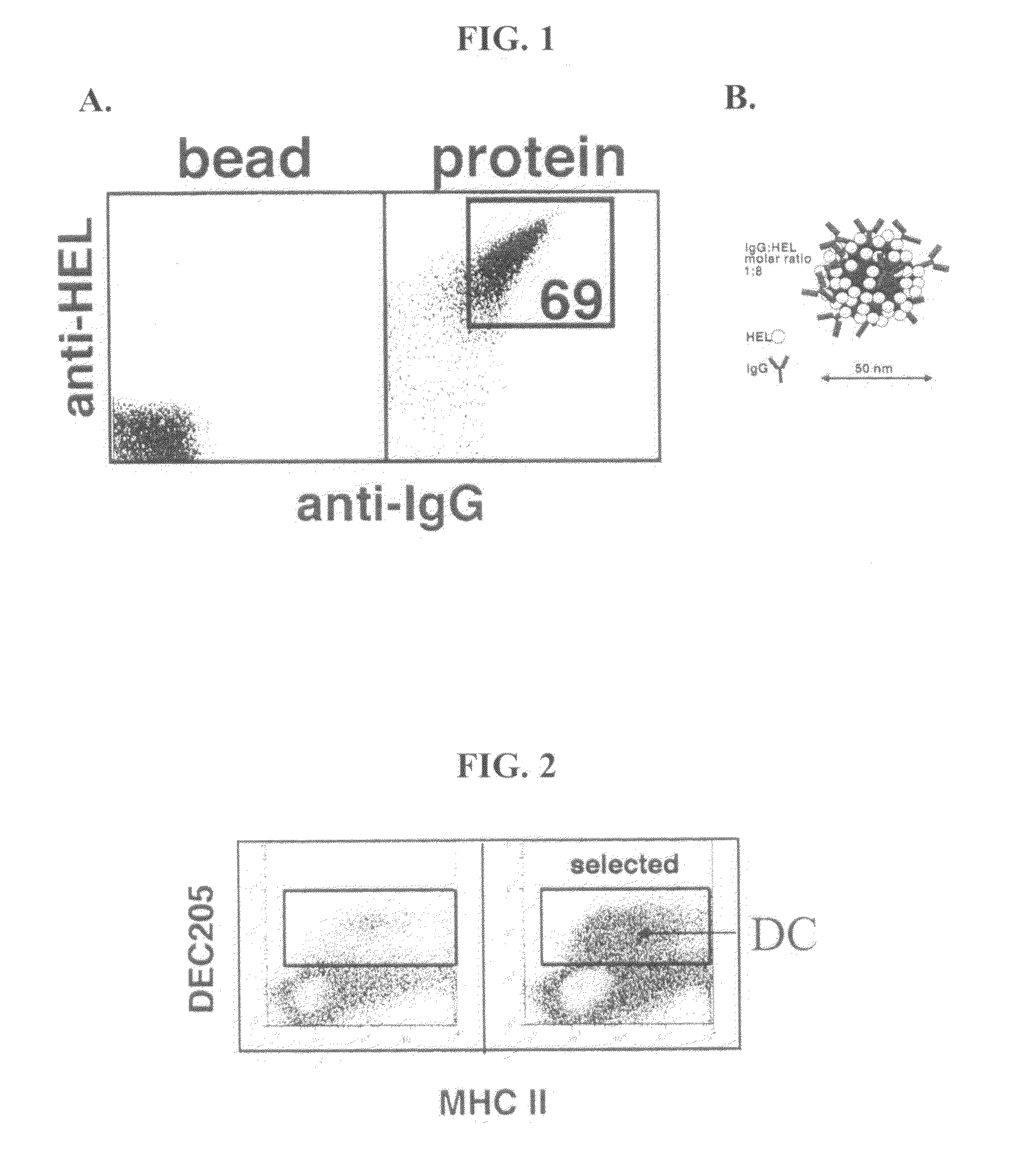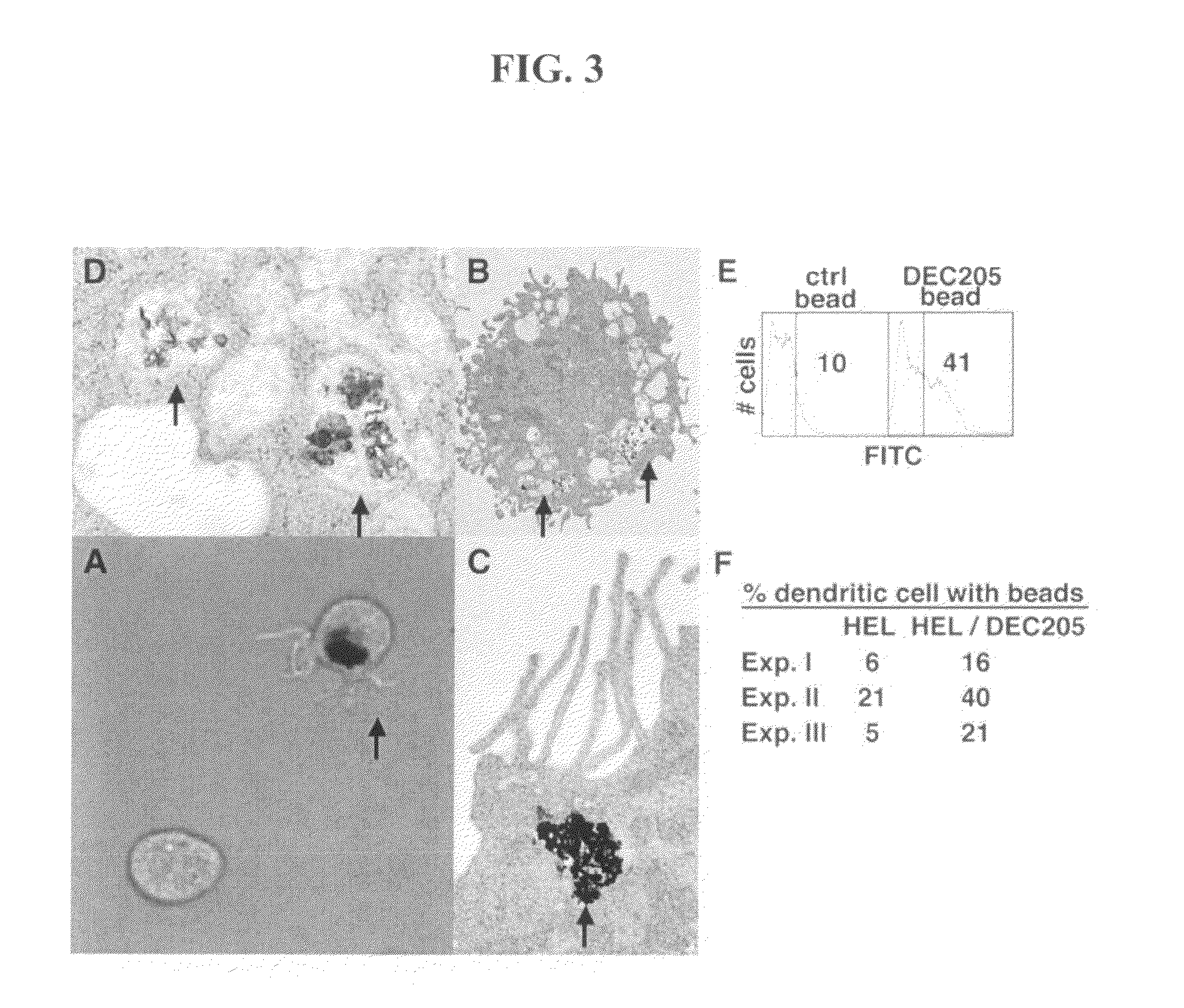Dendritic cell targeting compositions and uses thereof
a technology of dendritic cells and compositions, applied in the direction of antibacterial agents, carrier-bound antigen/hapten ingredients, antibody medical ingredients, etc., can solve the problems of difficult stimulation of responses against tumor-associated antigens, development of autoimmune disorders,
- Summary
- Abstract
- Description
- Claims
- Application Information
AI Technical Summary
Benefits of technology
Problems solved by technology
Method used
Image
Examples
example 1
Preparation of Carbon Nanoparticles
[0125]The plasma synthesis of CMNP from benzene may be performed using a dense medium plasma reactor (DMP), as described in U.S. Pat. No. 7,128,816. The DMP reactor allows the initiation and sustaining of discharges at atmospheric pressure environments, and in co-existing liquid / vapor media, and offers a high efficiency for the processing of liquid-phase materials. The reactor may be composed of a cylindrical glass chamber, and provided with two stainless-steel upper and bottom caps and a cooling jacket. The rotating, cylindrical, iron, upper electrode is equipped with a quartz jacket to avoid the penetration of the reaction media to the electrode-sustaining central shaft and bearings. The upper electrode has a disc-shaped end terminated in an interchangeable ceramic pin-array and holder. The lower electrode is hollow and has also an interchangeable conical cross-section end piece. In addition, the lower electrode is provided with channels for the ...
example 2
Immobilization of Biomolecules on Carbon Nanoparticles.
[0131]This example describes glutaraldehyde-mediated covalent coupling for the immobilization of biomolecules on carbon nanoparticles. The CMNP substrates were activated first by generating aldehyde groups which then react with the primary amino groups on biomolecules. The following immobilization procedure was developed to bind free biomolecules onto the surfaces of functionalized CMNP particles. Prior to immobilization, the CMNP substrate was washed with 50 ml of deionized water (twice) and 50 ml of 0.1 M pH 7 phosphate buffer. A 2% (weight) solution of glutaric dialdehyde (GD) was prepared by diluting 4 ml of 25% GD solution to 25 ml by using 0.1 M pH 7 phosphate buffer. Approximately 100 mg CMNP substrate and 50 ml of the 2% GD solution were added together into a 50-ml beaker, which was then placed into a water bath (controlled by a Fisher Scientific refrigerated circulator model 3210) and incubated for 2 h at 40° C. During ...
example 3
Biological Activity of Functionalized Nanoparticles by DCs
[0133]Magnetic nanoparticles were decorated with hen egg lysozyme (HEL)—a model antigen—and anti-DEC 205 IgG antibody (a DC-targeting antibody) according to the methods described in Example 2 in an antibody / antigen molar ratio of 1:8. A representation of the antigen / antibody-coated nanoparticles is shown in FIG. 1B. Cytofluorometric analysis of the particles before (left panel) and after (right panel) conjugation of the HEL and anti-DEC 205 IgG antibody is shown in FIG. 1A. The data indicate that magnetic nanoparticles were decorated with HEL and IgG, and that most of the particles were conjugated to the biomolecules (FIG. 1A).
[0134]Next, the preferential endocytosis of the nanoparticles by DCs was examined. Samples were incubated with nanoparticles prepared as described above. Following incubation, a magnetic field was applied to the sample (a strong permanent magnet) and cytofluorometric analysis was performed. FIG. 2 shows...
PUM
| Property | Measurement | Unit |
|---|---|---|
| diameter | aaaaa | aaaaa |
| diameter | aaaaa | aaaaa |
| average diameter | aaaaa | aaaaa |
Abstract
Description
Claims
Application Information
 Login to View More
Login to View More - R&D
- Intellectual Property
- Life Sciences
- Materials
- Tech Scout
- Unparalleled Data Quality
- Higher Quality Content
- 60% Fewer Hallucinations
Browse by: Latest US Patents, China's latest patents, Technical Efficacy Thesaurus, Application Domain, Technology Topic, Popular Technical Reports.
© 2025 PatSnap. All rights reserved.Legal|Privacy policy|Modern Slavery Act Transparency Statement|Sitemap|About US| Contact US: help@patsnap.com



